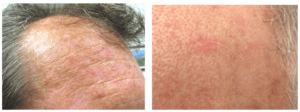Actinic Keratoses
What are Actinic Keratoses?
Actinic keratoses are scaly or gritty growths that can be subtle, or grow to be raised and thicker. They most often appear on the scalp, face, ears, lips, backs of the hands and forearms, shoulders, neck or any other areas of the body frequently exposed to the sun.
In the beginning, actinic keratoses are frequently so small that they are recognized by touch rather than sight. It feels as if you are running a finger over sandpaper. There are many more invisible (subclinical) lesions as visible ones on the skin surface.
Most often, actinic keratoses develop slowly and reach a size from an eighth to a quarter of an inch. Early on, they may disappear only to reappear later. Most become red, but some will be light or dark tan, pink, red, a combination of these, or the same color as your skin. Occasionally they itch or produce a pricking or tender sensation. They can also become inflamed and surrounded by redness. In rare instances, actinic keratoses can even bleed.
If you have actinic keratoses, it indicates that you have sustained sun damage and could develop any kind of skin cancer – not just squamous cell carcinoma.

Treatment Options
The best management of multiple actinic keratoses (AKs) over time utilizes a number of modalities both in the dermatology office and at home .
- Topical Medications- such as fluorouracil (Efudex, Carac) and imiquimod (Aldara, Zyclara) can all be used to larger areas to get rid of existing AKs and preventing newer ones. These should be repeated periodically.
- Cryosurgery- the use of liquid nitrogen to freeze individual raised lesions is efficient at eradicating even thicker AKs resistant to topical medications. It is the fastest way to get rid of specific pre-cancerous spots.
- Photodynamic Therapy- a medication is applied for an hour in the office, either Levulan or Ameluz, and is allowed to absorb into the skin. The area is then illuminated with blue light which activates the medication to kill pre-cancerous cells. Two treatments at least a month apart are generally recommended.
- Laser Surgery- cosmetic treatment with the Fraxel Dual laser has been shown to decrease actinic keratoses. Though it is not covered by insurance, the procedure improves the appearance of sun damaged and discolored skin while improving the health of the treated area by reducing AKs.

